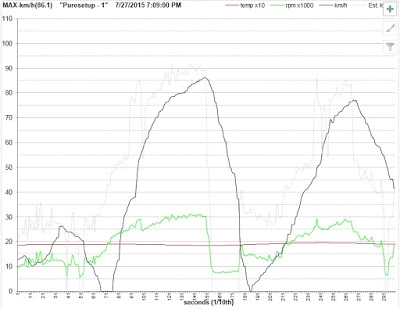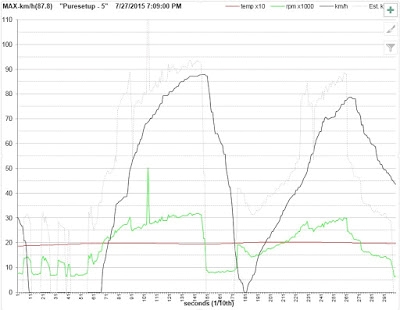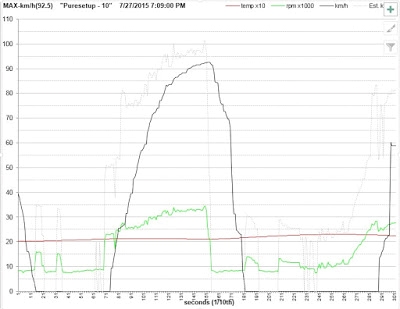Traxxas TQi Telemetry Radio and App: Part 4 - Car Run and Performance
Traxxas TQi Telemetry Radio and App: Part 4 - Car Run and Performance
Dec 15, 2017
Konrad
Boca Bearings used: SKU: #58-160C-2OS-AF2
Consistency:
It cannot be said any other way about my venture with Boca Bearings. I did not realize that this would so clearly make this Jato one of the fastest Jato's with run times over and over exactly the same. If you ever want to do "Speed Runs" the first thing is "consistency." If you can't send it down the lane every time each time all the time, there is nothing to compare. I've been able to create a screaming Jato that does this all the time. Below I have 13 speed runs that just go fast every time.
This has everything to do with the fact that I am getting power to the ground with every speed pass. The coolest thing I've noticed is that that any slight change that might slow down the vehicle causes the car to feel like it is slowing down and a real bore to run. I think I've spoiled myself in getting used to these speeds. I need to go faster and faster.
What's new in my car since Part 3:
A) Jaco "whites" to the rears
B) Helicopter gyro to assist with keeping it straight "ESky Professional Gyro EK2-0704"
Some could argue that the gyro is cheating and allows the electronics to make the car go fast. My analysis of my speed runs using telemetry allows for a unique -- unbiased analysis to counter this thought. If you compare my RPM to my GPS. This is a calculated theoretical speed which is "RPM" multiplied by "Transmission ratio" multiplied by "wheel size". The element that links all the data is my RC-mounted GPS. This is real-time -- recorded data points every 10th of a second. What makes this different than a regular GPS is that it can actually plot an acceleration path with the hundreds of speed readings recorded on every run.
I will demonstrate using the charts below that the light dotted grey line (calculated theoretical speed), closely follows the GPS speed. This means that power from the engine crank is being applied to real GPS speeds with mostly a consistent line. Everything that's been done to the Jato is getting the power from the crank to putting distance behind the Jato! And it's working. Without proper bearing spin-up the Jato power train couldn't do that. What I mean is without the performance of these Boca ceramic bearings none of this happens in the first place!
OK, here are my speed runs using my "Pure Setup" conditions. This combines all the Boca Bearings and other setup changes made through the previous submissions, where now the Jato is; running fast, temps are cool, and there's smoke!
Let's race:
This "pure setup" of my Jato is only for speed. Everything that I've done with Boca Bearings since my first submission is about my top speed. The GPS says it all at the end. From a consistent climbing speed of 55mph to 58mph within a 12 minute total record time for this submission. I am pleased with how the car consistently runs fast...er. Of course I've edited so we only see the compilation runs. I can assure you I was getting faster and better top speeds on each pass. What impressed me the most is that the car was ripping it up even on the return laps to the starting line. I thought I'd test out a different ratio reducing it by 0.25 and what a huge mistake that was. This car is so finely tuned that it made it feel very slow at 50 mph!
I am very pleased with the way the car is slowly increasing top speed with every pass. I can only assume the bearings are breaking in. Please keep in mind that I've only put approximately 6 tanks through these bearings from installation and they are performing after each pass. The best part is that next few line graphs of my 13 speed runs in the video show a consistent calculated to actual acceleration curves.












Note the little spike in theoretical acceleration curve (dotted grey) early in the acceleration of the GPS curve (solid black). This is the lower ration of the first gear shifting in the second gear. All theoretical is calculated on the second gear, hence the early shift pattern. This is likely why the curve looks as though it plateaus near the top and has a more gradual acceleration. But every curve is virtually the same data points repeated every time - 13 times. This is consistency!
Note: this was the acceleration curve before any Boca Bearings were used:

Note the theoretical curve isn't anywhere near the actual GPS (black line). Also note the acceleration (angle or profile of the black line) isn't as predictable.
The Traxxas real-time GPS speed values means I don't have mis-calculations of my top speed. Take a look at what happens when I spoof the GPS by intentionally losing the GPS signal and having the GPS satellite signals picked up on the other side. What you can do to spoof a "top-speed" reading is run it under an obstacle that loses the satellite signals, once you regain the signal the GPS throws out a huge reading. The Telemetry GPS rules this out very quickly, here's how:

You think, yeah I got it! When the data is plotted from my Traxxas telemetry GPS I can see how it goes off the charts and gives a false top speed. Be warned this happens, some GPS systems are programmed to ignore outlier values, however, this time they are only about 15 mph higher and not considered outliers.
This is how my RC has improved from my first spin tests in Part 2 of bearing replacements.
This has been an awesome experience. I want to thank Boca Bearings for making it all happen. I hope you can enjoy the difference as I have shown here.
